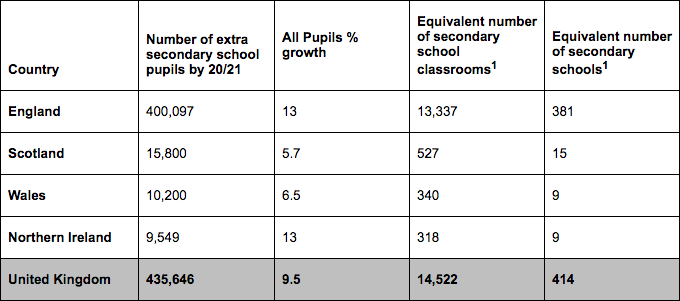NEW research has revealed that an additional 435,646 pupils will be joining the UK’s secondary school system in 2020, which would require over 14,500 additional secondary classrooms across the country.
The report, ‘The Secondary School Places Challenge’, looked at the challenge facing the secondary school system across the UK using Department of Education and devolved authority data. It shows the equivalent of 14,522 secondary school classrooms would need to be built over the next three years to ensure we have enough school places, which would equate to over 400 brand new 1,050 pupil secondary schools across the country.
Although the greatest school building requirement will be in England (13,337 classrooms), 340 classrooms would also be required in Wales, 527 in Scotland and 318 in Northern Ireland, to meet the projected growth in secondary school pupils.

Mark Robinson, Scape Group Chief Executive, told The Herald: “Secondary school pupil numbers are set to rise significantly and there is a real risk that if we do not increase the output of new secondary school classrooms there will be significant pressure on places across the UK. Such is the scale of the projected increase in secondary school pupils that the Government should now seek to develop a National School Building Strategy that brings together the Department of Education, local and regional government, and industry. We must ensure there is a joined-up approach that embraces modern methods of construction such as modular and offsite techniques, which can deliver schools quickly and cost-effectively.”
He added: “The Government must view this situation as a priority – it is critical that we do not fail our children by not providing enough new secondary school places. As primary school pupils move up the education system, an increased pressure is being placed on local authorities to deliver new secondary schools in a short timeframe. A collaborative approach between public and private sectors and Local and Central Government is key to bridging the school capacity gap – and a cohesive national strategy on modular for new schools could go a long way in reducing the amount of time it would take to provide areas with much-needed school places. However there needs to be significant investment behind this for it to have the desired effect.”
Fran Cox, Operations Director at Sunesis, said: “It currently takes far too long to secure planning for new schools and, with the equivalent of 14,522 classrooms required by 2020, we are running out of time to ensure pupils will have a sufficient space in which to learn. The Government should look at ways to speed-up decisions on school building. Commitment to offsite or modular construction is an obvious way in which Government can help tackle this school places challenge, as it offers clear timescales for delivery, flexibility and certainty of cost for both school extensions and new schools.”
















Add Comment